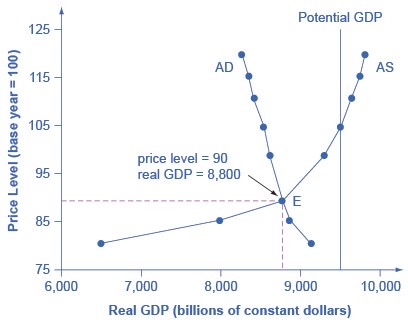Equilibrium - Aggregate Supply and Demand
What is the Equilibrium Point for Aggregate Supply and Demand?
- Marketing, Advertising, Sales & PR
- Accounting, Taxation, and Reporting
- Professionalism & Career Development
-
Law, Transactions, & Risk Management
Government, Legal System, Administrative Law, & Constitutional Law Legal Disputes - Civil & Criminal Law Agency Law HR, Employment, Labor, & Discrimination Business Entities, Corporate Governance & Ownership Business Transactions, Antitrust, & Securities Law Real Estate, Personal, & Intellectual Property Commercial Law: Contract, Payments, Security Interests, & Bankruptcy Consumer Protection Insurance & Risk Management Immigration Law Environmental Protection Law Inheritance, Estates, and Trusts
- Business Management & Operations
- Economics, Finance, & Analytics
What is the Equilibrium Point for Aggregate Supply and Demand?
The intersection of the aggregate supply and aggregate demand curves shows the equilibrium level of real GDP and the equilibrium price level in the economy. At a relatively low price level for output, firms have little incentive to produce, although consumers would be willing to purchase a large quantity of output. As the price level rises, aggregate supply rises and aggregate demand falls until the equilibrium point is reached.
The equilibrium, where aggregate supply (AS) equals aggregate demand (AD).

Related Topics
- Supply-Side Economics
- Say's Law
- Laffer Curve
- Neo-Classical Economics
- New Keynesian Economics
- Classical Economics
- Supply-Side Economics
- Keynesian Economics
- Keynes' Law
- Keynesian Analysis
- Demand Side Theory
- Market Forces
- Aggregate demand
- Aggregate Demand Curve (and shifts)
- Aggregate supply
- Aggregate Supply Curve (and Shifts)
- Aggregate Demand / Aggregate Supply Models
- Potential GDP
- Aggregate Supply and Demand Equilibrium
- Aggregate Supply and Aggregate Demand in Macroeconomics and Microeconomics
- Input-Output Model
- Stagflation
- Growth and Recessions in the Aggregate Demand - Aggregate Supply Model
- Unemployment in the Aggregate Demand - Aggregate Supply Model
- Inflation in the Aggregate Demand - Aggregate Supply Model
- Keynesian, Intermediate, and Neoclassical Zones